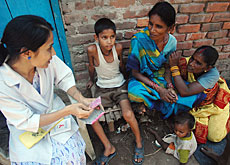A concerted effort needed to tackle Aids

In Switzerland, about three people in every 1,000 are infected with HIV/Aids; in Swaziland, up to 40 per cent of the population between the ages of 15 and 49 live with the virus.
The problem is not new, and every year December 1 is marked as World Aids Day. But in Africa infection rates rarely improve.
One of the organisations trying to rein in the disease is the Afro-European Medical and Research Network (AEMRN), an international non-governmental organisation with its headquarters in Bern.
Its president, Charles Senessie, a western-trained doctor from Sierra Leone, told swissinfo of some of the constraints faced by those working in the field.
One problem is the credibility gap, since HIV/Aids does not manifest itself immediately, and works instead by undermining the immune system.
“People tell you: ‘Well, we have never seen somebody dead of Aids,'” he pointed out. “They see the symptoms of tuberculosis, for example, but they don’t see what is underneath.”
There is a communication gap as well. Concepts that are familiar in the west may be hard to get across to ordinary people in Africa, as Congolese sociologist Johnson Belangenyi, who works as an educator and translator for AEMRN, explained.
“We have to train local people who can be interpreters. That means that they can get the knowledge from us, and they can impart this knowledge in the local languages to the people over there,” he said. “It’s not very easy to transmit the terminology into local languages, because these words do not exist.”
Differences
While on the one hand western know-how is vital to combat the disease in Africa, it is essential to take into account the major differences in conditions.
A telling instance is the use of figures.
“If I take the case of Switzerland, when they say it’s 0.4 per cent, it is exactly 0.4 per cent,” Senessie said.
The health system in the west is such that all cases are registered. And if the figures have risen in Switzerland it is not because infection rates are increasing.
“The old ones don’t die because the treatment is working,” added the doctor. “So the new ones coming in increase the figure.”
In Africa, by contrast, the figures that are quoted for Aids prevalence are estimates and projections. According to Senessie, it is precisely the lack of serious country-by-country research that hampers efforts to combat the problem.
“We are appealing to the western world to have a bit of patience with Africa. Put a lot of money into research, to know the magnitude of the problems and the differences between the problems. Then you can specifically target,” he suggested.
Senessie said that it was the realisation that “research is the key” which inspired him to set up AEMRN. And he stressed the importance of the private sector and non-governmental organisations, which can work at the grass-roots level.
Broader fight
At the same time, the fight against Aids in Africa is much broader than the provision of health care. This is why AEMRN also works in areas like agriculture and education.
“We know that these are part and parcel of the same fight,” warned Belangenyi. “When people are ignorant and illiterate, you give your message and it doesn’t get there. When people are hungry, even if they have the money to buy the medicine, they will give priority to the food.”
However well intentioned western donors may be, “coming with a treatment which doesn’t fit me, and giving me that,” is unhelpful he said. “I cannot even afford it, it’s not adapted to me.”
“Let’s try to find an African solution to our African problems.”
swissinfo
There are 33.2 million people living with HIV around the world.
2.1 million people with HIV/Aids died this year, most of them in sub-Saharan Africa where food supplies are scarce and health systems are weak.
UNAids estimates that about $8.3 billion (SFr10.3 billion) was spent last year in the treatment, prevention and care of orphans in developing countries, meeting a $7 billion to $10 billion target set five years ago.
According to the Federal Health Office, nearly 30,000 men and women were tested positive with HIV in Switzerland between 1985 and 2006.
The estimated number of new infections in Switzerland is 750-800 every year.

In compliance with the JTI standards
More: SWI swissinfo.ch certified by the Journalism Trust Initiative











You can find an overview of ongoing debates with our journalists here . Please join us!
If you want to start a conversation about a topic raised in this article or want to report factual errors, email us at english@swissinfo.ch.